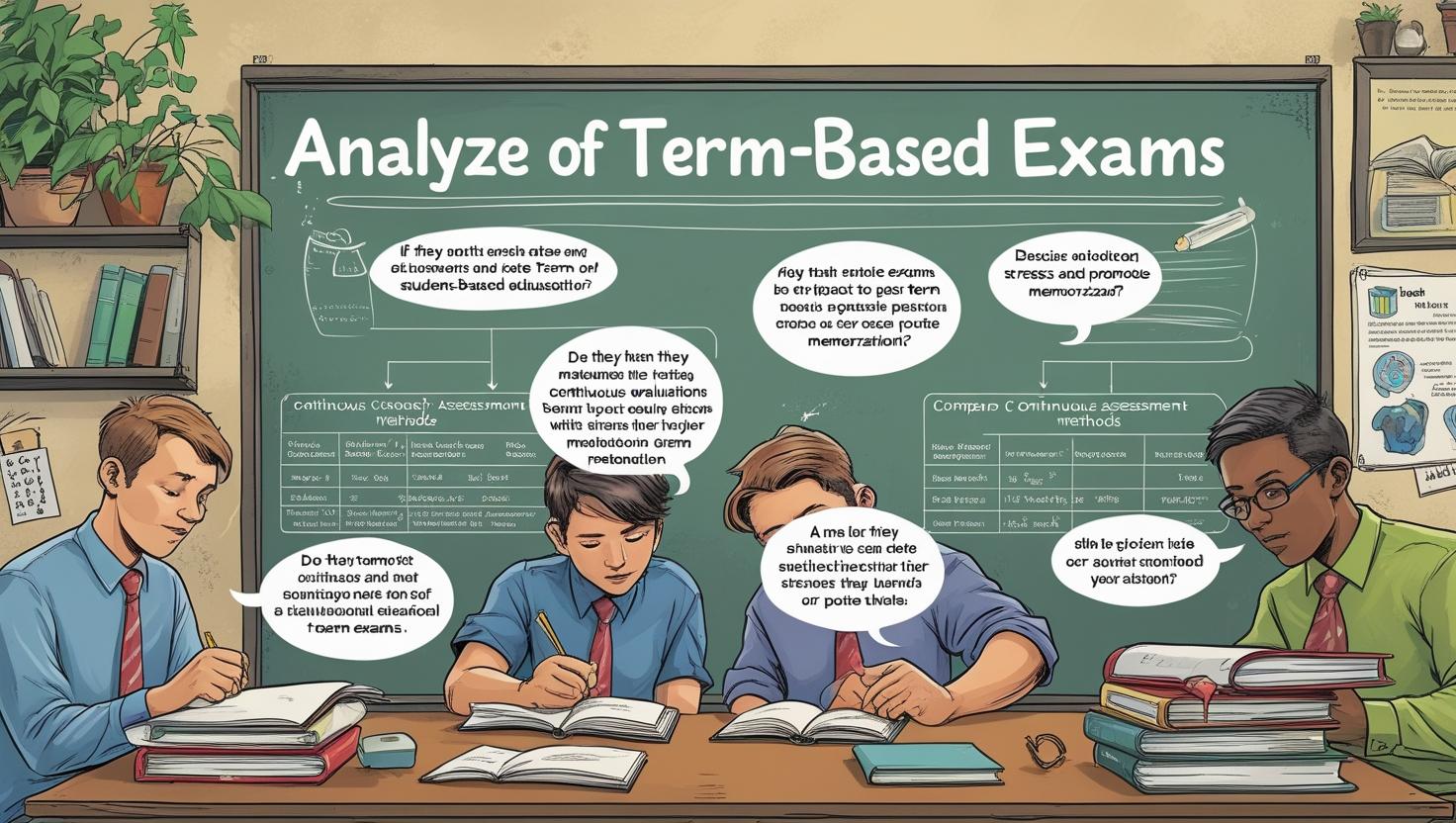1. Introduction to Term-Based Exams
Term-Based Exams in Education, Term-based exams are assessments conducted at the end of a specific academic period or term, typically dividing the school year into two or three parts. These exams are designed to evaluate students’ comprehension, retention, and application of knowledge acquired during the term. Unlike continuous assessment, which evaluates learners periodically through assignments, projects, and quizzes, term-based exams condense evaluation into a significant, timed assessment period. This method is deeply embedded in education systems around the world, especially in formal schooling frameworks. Term-based assessments are often written and test theoretical understanding across a range of subjects.
The rationale behind these exams is to measure not just recall but also critical thinking and synthesis of concepts taught. They also provide a standardized measure to compare student performance within and across schools. While term-based exams have long served as a benchmark for academic success, they are also critiqued for pressurizing students and promoting rote learning. This article explores the structure, benefits, drawbacks, and evolving relevance of term-based exams in the 21st-century education landscape.
2. Historical Background and Evolution
The origin of term-based exams can be traced back to the formalization of education systems in Europe and Asia, especially during the 18th and 19th centuries. British colonial education, for instance, introduced formal assessments in colonies like India, where term-wise exams were a cornerstone of their evaluation system. These were initially oral but later evolved into written tests with the spread of literacy. The industrial revolution and the subsequent need for a trained and disciplined workforce necessitated measurable outcomes, leading to the normalization of examinations at the end of academic terms.
Term exams became critical to curriculum development, teacher planning, and student progression. In the United States, the 20th century saw standardized testing rise in popularity, further solidifying the place of term-based assessments. Over time, as education diversified and expanded globally, variations emerged, including semester and trimester systems, but the fundamental concept of term-based assessment remained consistent. Today, the term-based exam has adapted with digital formats and analytical evaluation tools while maintaining its foundational goals.
3. Structure and Scheduling of Term-Based Exams
Term-based exams are typically scheduled at the conclusion of defined academic periods, which could be trimesters, semesters, or quarterly terms, depending on the institutional framework. Each exam period usually spans 1 to 2 weeks, where students are assessed in all major subjects. The structure includes multiple formats: essay-type questions, short-answer questions, objective-type multiple-choice questions, and problem-solving tasks. Schools often provide detailed syllabi and revision plans ahead of exams to guide student preparation. Some institutions incorporate mid-term assessments as preparatory evaluations leading up to the final term exam.
The exam timetable is crafted carefully to avoid cognitive overload, typically spacing exams over consecutive days. In high-stake educational setups, exam papers are confidentially prepared and checked by a separate examination board. Many educational institutions also allocate study breaks or preparatory leave before the term exam period, giving students time for revision. The grading system used may differ—letter grades, percentage marks, or grade points—depending on national or institutional policies.

4. Academic Benefits of Term-Based Exams
Term-based exams offer several academic benefits. Firstly, they provide a cumulative assessment that encourages students to consolidate their learning over a defined period. This consolidation helps build long-term memory, as students must revisit earlier topics to prepare effectively. Secondly, term-based exams create structured learning goals and deadlines, which can improve time management and discipline in students. Teachers benefit from such exams as they offer tangible indicators of student progress, helping identify learning gaps and re-strategize lesson plans.
Moreover, standardized term exams foster academic accountability across schools and systems by offering measurable and comparable results. They also form the basis for academic progression, certification, and sometimes scholarships. For high-achieving students, these exams serve as opportunities to showcase academic excellence. Lastly, term exams prepare students for larger external examinations, such as board exams or entrance tests, by familiarizing them with rigorous and timed testing formats, thus building exam temperament and resilience.
5. Psychological and Social Impacts on Students
While term-based exams have academic merits, they can also lead to significant psychological and social impacts. One of the major concerns is exam stress, which affects students’ mental health. The pressure to perform, coupled with parental and societal expectations, often leads to anxiety, depression, and even burnout. Younger students, in particular, may struggle to cope with the academic load and fear of failure. In competitive educational systems, the results of term exams can influence self-esteem and peer relationships, leading to social comparisons and inferiority complexes.
In extreme cases, high-stakes term exams have been linked to increased student suicide rates, especially in South and East Asia. Socially, term exams may widen the gap between students of different socio-economic backgrounds, as wealthier students often have access to private tutoring and better resources. The constant pressure to outperform peers also fosters a culture of unhealthy competition rather than collaborative learning. Hence, while term-based exams aim to assess learning, they inadvertently shape student psychology and peer dynamics.
6. Comparison with Continuous Assessment Methods
Continuous assessment (CA) involves regular evaluation through assignments, presentations, class participation, and projects throughout the term. Compared to term-based exams, CA offers a broader and more holistic view of a student’s academic abilities. While term exams measure performance at a specific point in time, CA evaluates learning as an ongoing process. One advantage of CA is that it reduces exam pressure by spreading assessment over time. It also allows teachers to assess practical skills, creativity, and communication, which are often ignored in traditional exams.
However, term-based exams have the advantage of standardization and scalability, making them more suitable for large educational systems. Some critics argue that CA may lead to grade inflation due to subjective teacher judgments. Others believe that without term exams, students may lose the motivation to revise and synthesize learning. The most effective approach could be a hybrid model, combining the reliability of term-based exams with the flexibility and inclusiveness of continuous assessments.
7. Role of Technology in Modern Term Exams
In the 21st century, technology has transformed how term-based exams are designed, conducted, and assessed. Computer-based testing (CBT) is now a viable alternative to paper-based exams, offering speed, security, and adaptability. Many institutions use Learning Management Systems (LMS) like Google Classroom or Moodle to share exam materials and guidelines. With the integration of AI, adaptive testing is emerging, where the difficulty level adjusts according to student responses. Automated grading systems are used for multiple-choice questions and even some types of essays. Online proctoring software ensures academic integrity during remote exams.
Moreover, analytics tools help educators understand student performance trends and learning gaps through visual dashboards. During the COVID-19 pandemic, the shift to online term exams accelerated, highlighting both opportunities and challenges. Issues such as digital divide, internet connectivity, and exam security remain concerns. Despite these, technology offers promising solutions to enhance the efficiency, accessibility, and fairness of term-based assessments in education.

8. Criticism and Limitations of Term-Based Exams
Term-based exams have faced growing criticism from educators, psychologists, and policymakers. One key limitation is their focus on rote memorization rather than analytical or critical thinking. Many students learn only for the sake of passing exams, not for deeper understanding, which undermines the purpose of education. Additionally, a single exam determining a large portion of the grade can be unfair to students who may underperform due to health or personal issues.
Critics also point to the narrow scope of term exams, which fail to assess practical skills like teamwork, creativity, or emotional intelligence. The rigid nature of standardized exams does not cater to diverse learning styles, disadvantaging students with learning disabilities or different cognitive strengths. Furthermore, exam malpractices such as cheating, paper leaks, and unfair grading practices can compromise their integrity. These limitations suggest that while term exams serve some purposes, they are insufficient as the sole method of assessing student learning, calling for more balanced and diversified evaluation strategies.
9. Global Trends and Practices
Different countries implement term-based exams with varying emphasis and frequency. In the United Kingdom, GCSEs and A-levels are major term-end assessments, supplemented with internal exams. In Finland, a country known for its progressive education system, term-based testing is minimal, emphasizing trust in teachers and project-based learning. India follows a trimester or semester pattern in most boards like CBSE and ICSE, where term-based exams are heavily emphasized. In Japan and South Korea, high-stakes term exams are deeply rooted in the academic culture, significantly influencing college admissions.
The United States employs a mixed model with end-of-term exams and continuous assessments, especially in higher education. Recent trends show a move towards competency-based assessments and portfolio evaluations globally. International frameworks like IB (International Baccalaureate) integrate term-end exams with internal assessments to provide a holistic learning experience. These global practices reflect a trend toward reforming assessment systems to be more inclusive, skill-based, and learner-centric, while still retaining elements of term-based evaluations for structure and accountability.
10. Future of Term-Based Exams
The future of term-based exams is likely to evolve toward a more integrated and flexible assessment model. As education shifts focus from memorization to critical thinking, collaboration, and creativity, term exams must adapt to assess these competencies. One potential direction is the blending of formative and summative assessments, where term exams are shorter, frequent, and combined with ongoing evaluation tools. Personalized learning through AI may lead to adaptive testing, making exams more student-centered.
Project-based learning, portfolios, and peer-assessment could supplement term exams to ensure a comprehensive understanding of student capabilities. Policymakers and educators are also exploring competency-based curricula, which measure mastery rather than time-bound performance. With technology enabling remote and real-time assessment, future term exams could become more inclusive and dynamic. However, to ensure equity, considerations around access to digital resources and training for educators are critical. While term-based exams may not disappear, they will likely transform into more balanced tools within a broader assessment ecosystem.
References
- Black, P., & Wiliam, D. (1998). Assessment and Classroom Learning. Assessment in Education: Principles, Policy & Practice, 5(1), 7–74.
- OECD (2013). Synergies for Better Learning: An International Perspective on Evaluation and Assessment. OECD Publishing.
- Harlen, W. (2007). The Quality of Learning: Assessment Alternatives for Primary Education. Cambridge Primary Review Research Survey.
- UNESCO (2017). Rethinking School Exams: International Trends and Innovations. UNESCO Publishing.
- Klenowski, V. (2010). Portfolio Assessment in Schools: Effective Assessment for Learning. Assessment in Education: Principles, Policy & Practice, 17(4), 409–423.
- Andrade, H., & Heritage, M. (2018). Using Formative Assessment to Enhance Learning, Achievement, and Academic Self-Regulation. Routledge.

goo0y5
I really like your blog.. very nice colors & theme. Did you make this website yourself or did you hire someone to do it for you? Plz respond as I’m looking to construct my own blog and would like to find out where u got this from. thanks a lot
ubd43v
You could certainly see your skills within the paintings you write. The sector hopes for more passionate writers such as you who aren’t afraid to say how they believe. At all times follow your heart.
Howdy! Do you use Twitter? I’d like to follow you if that would be ok. I’m absolutely enjoying your blog and look forward to new posts.
I’m still learning from you, as I’m trying to reach my goals. I certainly enjoy reading everything that is written on your site.Keep the stories coming. I enjoyed it!
This is very interesting, You’re a very skilled blogger. I have joined your rss feed and look forward to seeking more of your magnificent post. Also, I have shared your site in my social networks!
I would like to thnkx for the efforts you have put in writing this web site. I am hoping the same high-grade website post from you in the upcoming also. Actually your creative writing abilities has encouraged me to get my own website now. Actually the blogging is spreading its wings fast. Your write up is a good example of it.
It?¦s really a cool and helpful piece of info. I?¦m glad that you simply shared this useful information with us. Please keep us informed like this. Thank you for sharing.
I just couldn’t depart your site prior to suggesting that I actually enjoyed the standard info an individual supply to your visitors? Is going to be again frequently in order to check up on new posts.
I adore meeting utile info, this post has got me even more info! .
Your mode of explaining everything in this piece off writing is truly pleasant, every one
can without difficulty know it, Thanks a lot. https://Hallofgodsinglassi.wordpress.com/
As I website owner I conceive the subject matter here is rattling fantastic, thanks for your efforts.
We are a gaggle of volunteers and starting a brand new scheme in our community. Your website provided us with valuable info to paintings on. You have performed an impressive job and our entire neighborhood will be thankful to you.